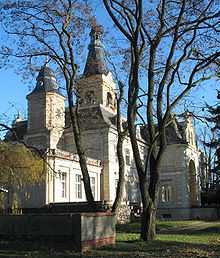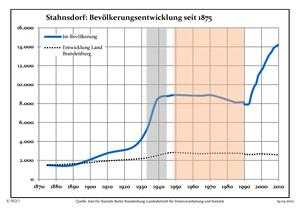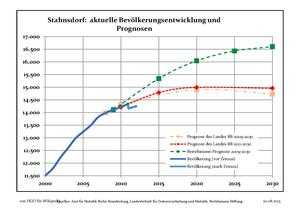Stahnsdorf
| Stahnsdorf | ||
|---|---|---|
| ||
 Stahnsdorf | ||
Location of Stahnsdorf within Potsdam-Mittelmark district  | ||
| Coordinates: 52°23′32″N 13°13′00″E / 52.39222°N 13.21667°ECoordinates: 52°23′32″N 13°13′00″E / 52.39222°N 13.21667°E | ||
| Country | Germany | |
| State | Brandenburg | |
| District | Potsdam-Mittelmark | |
| Subdivisions | 4 Quarters | |
| Government | ||
| • Mayor | Bernd Albers (Bürger für Bürger) | |
| Area | ||
| • Total | 49.07 km2 (18.95 sq mi) | |
| Elevation | 44 m (144 ft) | |
| Population (2012-12-31)[1] | ||
| • Total | 14,245 | |
| • Density | 290/km2 (750/sq mi) | |
| Time zone | CET/CEST (UTC+1/+2) | |
| Postal codes | 14532 | |
| Dialling codes | 03329 | |
| Vehicle registration | PM | |
| Website | www.Stahnsdorf.de | |
Stahnsdorf is a municipality in the Potsdam-Mittelmark district, in Brandenburg, Germany.
Geography

It is situated 20 km southwest of Berlin (centre), and 12 km east of Potsdam.
Quarters
- Güterfelde
- Schenkenhorst
- Sputendorf
- Stahnsdorf
History
Stahnsdorf was first documented in 1264 and originally consisted only of its old center and a formerly important merchant road from Saxony via Güterfelde and Stahnsdorf over the River Bäke towards Spandau (Today a part of Berlin). With the construction of the Teltow Canal in the early 20th Century, the opening of the Southwest cemetery in April 1909, the Wilmersdorfer Waldfriedhof (also a cemetery) and Friedenauer forest-cemetery in 1913 and the opening of the S-Bahn route from Berlin-Wannsee in June 1913 the development in a Berlin suburb began. In the following decades, the current site was created by the development of privately owned homes, the connection to Berlin-Lichterfelde by a tram and building a settlement for workers at the Bosch manufactures in Kleinmachnow. 1931 Stahnsdorf WWTP was put into operation, where waste water from the south of Berlin was treated. It was one of the first plants to produce biogas. The construction of the Berlin Wall on 13 August 1961 severed the connections to the bordering Berlin. In the communist era, the place was dominated economically, especially through the semiconductor business as a major operation and farms. The fall of the Berlin Wall set a renewing development by inflows, opening new home communities, and in recent years by commercial development, particularly in "Green Park", a large industrial park. On 1 January 2002 Stahnsdorf in its present form was formed by the incorporation of the towns Güterfelde, Schenkenhorst and Sputendorf.
Demography
-

Development of Population since 1875 within the Actual Boundaries (Blue Line: Population; Dotted Line: Comparison to Population Development of Brandenburg state; Grey Background: Time of Nazi rule; Red Background: Time of Communist rule)
-

Recent Population Development (Blue Line) and Forecasts
References
- ↑ "Bevölkerung im Land Brandenburg nach amtsfreien Gemeinden, Ämtern und Gemeinden 31. Dezember 2012 (XLS-Datei; 83 KB) (Einwohnerzahlen auf Grundlage des Zensus 2011)". Amt für Statistik Berlin-Brandenburg (in German). 31 December 2012.
External links
- Official website of Stahnsdorf
- Stahnsdorf South-Western Cemetery
- Official website of the Stahnsdorf Voluntary Fire Department
